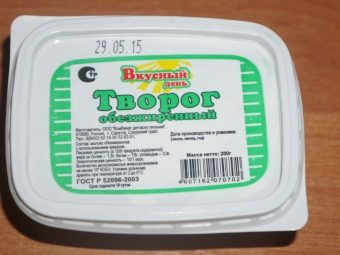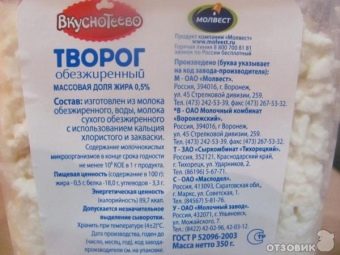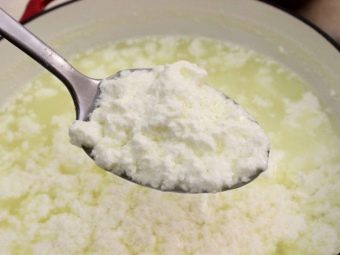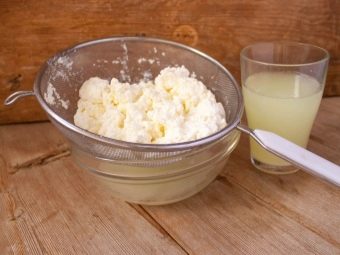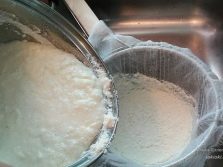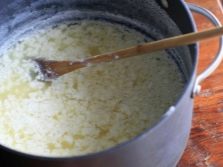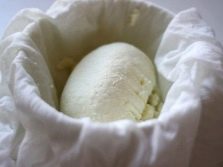Fat-free cottage cheese: the benefits and harm, nutritional and energy value

Probably everyone in childhood heard from their mothers and grandmothers about the beneficial properties of cottage cheese. And indeed, it is quite a useful and nutritious product, rich in minerals, essential amino acids and a set of vitamins, so necessary for the body.
For a diet more often prefer low-fat cottage cheese.
Special features
Nowadays, proper nutrition has become fashionable again - people pay special attention to their health and, in particular, to their body mass index. Adhering to a variety of diets, women and men choose low-calorie foods. This fact pushes manufacturers to produce lactic acid products with low energy value. This fashionable trend could not get around and beloved by all the curd.
For people concerned about weight loss, a special low-fat product has been created that differs from the traditional low-calorie content. This was made possible by reducing the percentage of fat in pasteurized milk, which is used as the main raw material for the manufacture of fermented milk product. Fat-free cottage cheese is easier for the body to digest and faster to digest than normal, has a pleasant taste and exceptional protein value.
How do?
Cottage cheese, as is known, is produced from cow's milk by pasteurization. For the fat-free version, respectively, the milk is defatted and a little buttermilk is added to it, as well as a special leaven consisting of anaerobic bacteria that cause effective lactic acid fermentation. In some cases, rennet component, a solution of calcium chloride or pepsin is introduced into the composition. All components are subjected to heat treatment, during which a dense soft granular clot is released from the whey - this is cottage cheese. It is packaged in plastic packaging and delivered to the final consumer.
It is necessary that the complete manufacturing technology be observed correctly - only in this case the product will be fragrant, tasty and most useful. In addition, at dairy plants, special attention is paid to the quality control of raw materials - that is why, even before pasteurization begins, milk is checked for the presence of pathogenic bacteria, as well as wholeness and fat content.
Composition, glycemic index and nutritional value
Low-fat cottage cheese is sold for sale, containing about 15-25% protein. This product is distinguished by a light yellow color, a uniform structure without any impurities and a characteristic fermented milk smell.
The following microbiological indicators are established for the curd: salmonella per 25 g or E. coli per 0.00001 g is not detected. This composition complies with all existing sanitary standards and indicates the highest quality of the product, so you can not worry about possible infection with pathogenic microflora. From this point of view, cottage cheese is absolutely safe.
The product is rich in elements important for normal growth and development of the human body. Calcium in its structure strengthens bones and muscle tissue, affects the conductivity of nerve impulses, promotes blood clotting, is responsible for the strength of teeth and the hardness of nails.
A characteristic feature of lactic acid products is that calcium is present in them along with lactic acid with the formation of lactate - this component is fully absorbed by children and adults.
Cottage cheese is saturated with proteins, and they are known to contain amino acids, which are the key building material of all tissues and cells of the human body. It is because of this that it is especially recommended for children, as well as elderly people. Cottage cheese is the only lactic acid product that contains casein protein. It improves metabolism and speeds up metabolism.
Lecithin phospholipids, as well as kefalin contribute to the normal course of neural regulation processes.Amino acid methionine is characterized by a pronounced hepaprotective effect and reduces the risk of fatty degeneration of liver cells.
Cottage cheese has a large amount of type B vitamins. They help to maintain the normal functioning of all internal systems and, together with magnesium, normalize the activity of the nervous system, calm and normalize sleep, are used in the complex treatment of neuroses, obsessive states and tics.
In low-fat cottage cheese accumulates a significant concentration of phosphorus and iron, which contribute to the normal functioning of the whole organism, improve hemoglobin, save from anemia and anemia.
Cottage cheese is especially recommended for people with obesity, gout, thyroid abnormalities, as well as those weakened by severe chronic diseases. It allows you to quickly restore and normalize the work of all vital organs.
Cottage cheese also contains selenium, which is responsible for the body's resistance to infections and viral diseases, and also participates in regulating the work of the heart and blood vessels. High content of zinc in the product, which is necessary for strengthening bones and muscle tissue. Without cobalt, healthy blood cells are not produced in the blood, and manganese normalizes blood formation.
Calorie fat-free product is minimal - per 100 g of cottage cheese accounts for only 75-110 kilocalories, it is due to this product is especially recommended for pregnant women, and also included in the diet and sports nutrition. Unfortunately, vitamins A, E, D and K can be absorbed by the body only in the presence of fat, therefore they are inaccessible to the human body as part of low-fat cottage cheese.
What is useful?
For complex treatment of individual pathologies, in addition to medications, physicians recommend a diet to their patients based on the use of low-fat cottage cheese. The healing benefits of this product, as evidenced by the reviews, is great.
With increased pressure, it helps to strengthen the walls of blood vessels and stabilize blood pressure due to the presence of sodium salts. In this case, it can be eaten both raw and in the form of sweet casseroles and pudding desserts. In patients with ischemic heart disease, it is recommended to use low-fat cottage cheese daily.
Due to the low acidity, cottage cheese is especially effective in chronic disorders of the digestive tract, and in colitis, intestinal disorders and enteritis, cottage cheese accelerates the body's recovery process due to the large presence of protein and vitamins.
When overweight, low-fat cottage cheese helps to burn fat, therefore it helps to gently get rid of unnecessary kilograms. In this case, it will be most useful to receive cottage cheese along with fresh vegetables and fruits.
Cottage cheese is truly indispensable for liver pathologies - it allows the tissues of an organ to recover quite quickly and fully renewed. Doctors often recommend curd diets for problems with the gallbladder - the product reduces inflammatory manifestations in the body and improves cholagogue.
Cottage cheese can be used by diabetics, it has a low insulin status and is rich in carbohydrates in an easily digestible form - this is extremely important when prescribing a diet food.
Most expectant mothers include low-fat cottage cheese in their daily diet. The increased presence of proteins in combination with reduced calorie allows them to get all the vitamins and amino acids necessary for normal growth and development of the fetus without the risk of gaining excess weight.
And of course, low-fat dairy product is very important for young children. It is usually administered in the diet after 8 months. It is necessary for babies to compensate for calcium deficiency and normal growth of bones and muscles of a child.
In addition, the use of the product is manifested in its diuretic properties, so that it can be recommended for patients with pathologies of the urinary system, and in addition, persons prone to edema (but in limited quantities).
Cottage cheese has lipotropic properties, is involved in the synthesis of hemoglobin, as well as the regeneration of nerve fibers. With daily use of the product, bone and cartilage tissue is strengthened, so it is recommended for mandatory inclusion in the diet for all people with increased physical activity, as well as for men and women over 40 years of age.
Harm
Despite the unconditional benefit of low-fat cottage cheese, there is a list of diseases in which its use is contraindicated.
The product is harmful in large quantities in acute renal failure, as well as atherosclerosis. Patients with gastritis can not get a sour product - you should give preference to cottage cheese with a neutral taste.
Children under 2 years should not be given cottage cheese too often - this can lead to kidney problems. Keep in mind that on the shelves of supermarkets and small shops today presents a huge amount of low-quality product, which contains vegetable oils (lanolin, palm or coconut). They significantly reduce the digestibility of the product and reduce its effectiveness in the treatment.
Beware of various emulsifiers and flavor enhancers that can harm the body.
How to cook?
If you do not trust the quality of the finished products, you can always cook low-fat cottage cheese with your own hands at home, besides these recipes are very simple. All that is needed for this is raw materials, a solid pan with a thin bottom, a sieve and a little time.
The technology of preparation is quite simple: the sour milk is poured into a cooked cooking container and placed on a low fire or water bath. In order to prepare the product faster, it is periodically mixed. As soon as a lump of light color is formed, which will easily move away from the whey, the curd is ready. After that, drain the billet - for this, a colander or metal sieve is lined with gauze folded several times and the contents of the cooking pan are poured. Gauze with fermented milk product must be tied and hung to completely drain the liquid. If it is necessary for the curd to turn out dry and crumbly, it is left in a sieve or colander, covered with polyethylene and placed under pressure. Milk should not be placed on a strong fire - at elevated temperatures, the billet will start to roll up and the mass will become stiff as the rubber leaves.
If in your kitchen arsenal there is a microwave, then you can make low-fat cottage cheese in it. To do this, the sour pasteurized milk should be placed in a glass container and put into the oven for a couple of minutes. This time is quite enough for the milk to curl and completely separated from the acidic whey.
If you do not have time to wait for the milk to turn sour - it does not matter, in this case, homemade curd will require a little bit of yogurt or kefir, which are a good source of lactic acid bacteria, which break down the composition into curd and whey.
In order to prepare the product in this way, you should place the pan with the prepared raw material on a low fire, and when the liquid warms up to 65-70 degrees, add the kefir in it at the rate of 100 g ferment per liter of milk. Sometimes housewives put sour cream, but in this case, the cottage cheese will be fat and its calorie content will increase by 13-15%.
For those who, because of frequent diets and dryers, do not have enough calcium, the option of making cottage cheese using liquid calcium chloride, which can be purchased at any pharmacy, is suitable.
The pan with the prepared pasteurized milk should be put on the stove, and only the drink will heat up - squeeze out the ampoule of the preparation and continue the weeping until all the large and small flakes gather into a single lump.
As it is?
Low-fat cottage cheese is eaten raw, used for hearty casseroles, fragrant cheesecakes and curd, often included in vegetable salads and even put on sandwiches.
In order not to harm the body, you should follow some recommendations for its use.
Children up to 3 years old should eat special curds that contain a balanced amount of BJU, as well as minerals. From the age of 3, babies can add to their ration the usual low-fat cottage cheese, while the daily rate should be approximately 50-70 grams per day.
Pregnant women need cottage cheese, but in order not to create an increased load on the kidneys, the use of the product should not be higher than 200 g in two or three days.
It is very important to regularly feed the cottage cheese into the body of a young nursing mother - in this case, the daily rate is 150 g.
Athletes protein is important for building muscle. In order to feed the tissues with the necessary protein, one should use smoothies with cottage cheese 60-100 minutes before the workout and half an hour after it. The daily rate for an adult should be about 200 g.
The same amount of cottage cheese should be used daily by all who seek to lose weight. There are many diets that recommend increasing its intake to 300 g, but such advice is fraught with unpleasant consequences, since high doses of calcium can significantly disrupt the work of the kidneys and urinary system.
Everyone knows that eating at night is harmful, but if you can’t do without snacking, it’s better to use cottage cheese, but only low-fat.
On the benefits of low-fat cottage cheese, see below.






